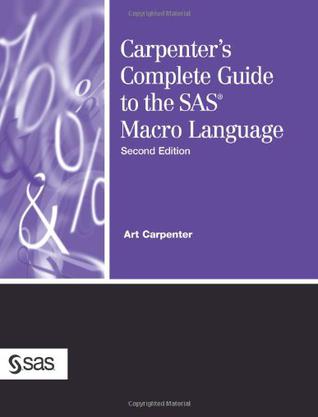Guide To The Sas Macro Language

Statistical Computing Seminar: Introduction to SAS Macro Language. This seminar is designed to introduce the basics of SAS macro language. Here is the program on which the seminar is based. SAS® 9.3 Macro Language: Reference. X SAS Macro Language. Recommended Reading • Carpenter's Complete Guide to the SAS Macro Language.
Statistical Computing Seminar: Introduction to SAS Macro Language This seminar is designed to introduce the basics of SAS macro language. Here is the on which the seminar is based. In this seminar we will cover the following topics:. Macro variables.

Macro functions. symput and symget function to pass information to and from a data step. Creating a macro variable using proc sql. Creating a list of file names for a data step using a macro program. A macro program for repeating a procedure multiple times The SAS macro language is a very versatile and useful tool.
It is often used to reduce the amount of regular SAS code and it facilitates passing information from one procedure to another procedure. Furthermore, we can use it to write SAS programs that are “dynamic” and flexible. Generally, we can consider macro language to be composed of macro variables and macro programs. In this seminar we will demonstrate how to create macro variables and how to write basic macro programs. Macro Variables A macro variable in SAS is a string variable that allows you to dynamically modify the text in a SAS program through symbolic substitution. The following example demonstrates how to create and use a macro variable. First we set up some system options to have a more concise output style.
This book is designed to both introduce the SAS System Macro Language and to provide a reference tool for experienced macro programmers. Because of the complexity of the macro language, this book is intended for SAS programmers with a good general grounding in base SAS software.
Regardless of how you are planning to use this book, in order to get the maximum benefit, you should be well versed in the use of the DATA step and fairly comfortable in the use of basic procedures. The macro language has a number of similarities to the language that is used in SAS DATA steps. In order to maximize the usefulness of the examples in the book, you need to be able to build on these similarities.
Students unfamiliar with the DATA step should first take a basic programming course in SAS such as SAS® Fundamentals: A Programming Approach (offered by SAS Institute Inc.) or an equivalent course. It is the intent of this book to provide the reader with both a guide and a reference to the SAS macro language. Through its use, the reader will be able to write SAS macros, convert SAS code to macros, and use macros to generalize SAS programs to maximize their usefulness. The book assists the reader so that he or she will understand the general make up and operation of the macro facility and the macro language know the syntax that is used in the macro language be able to define macro variables and pass macro parameters understand and be able to utilize the different macro referencing environments or scopes know about the phases of execution when macro statements are present be able to develop and call SAS macros know how to reference SAS macro functions and automatic macro variables be able to use macro statements within SAS macros.
Sas Macro Language 1: Essentials
See the tab for a review of this book, or to make comments and report typos.